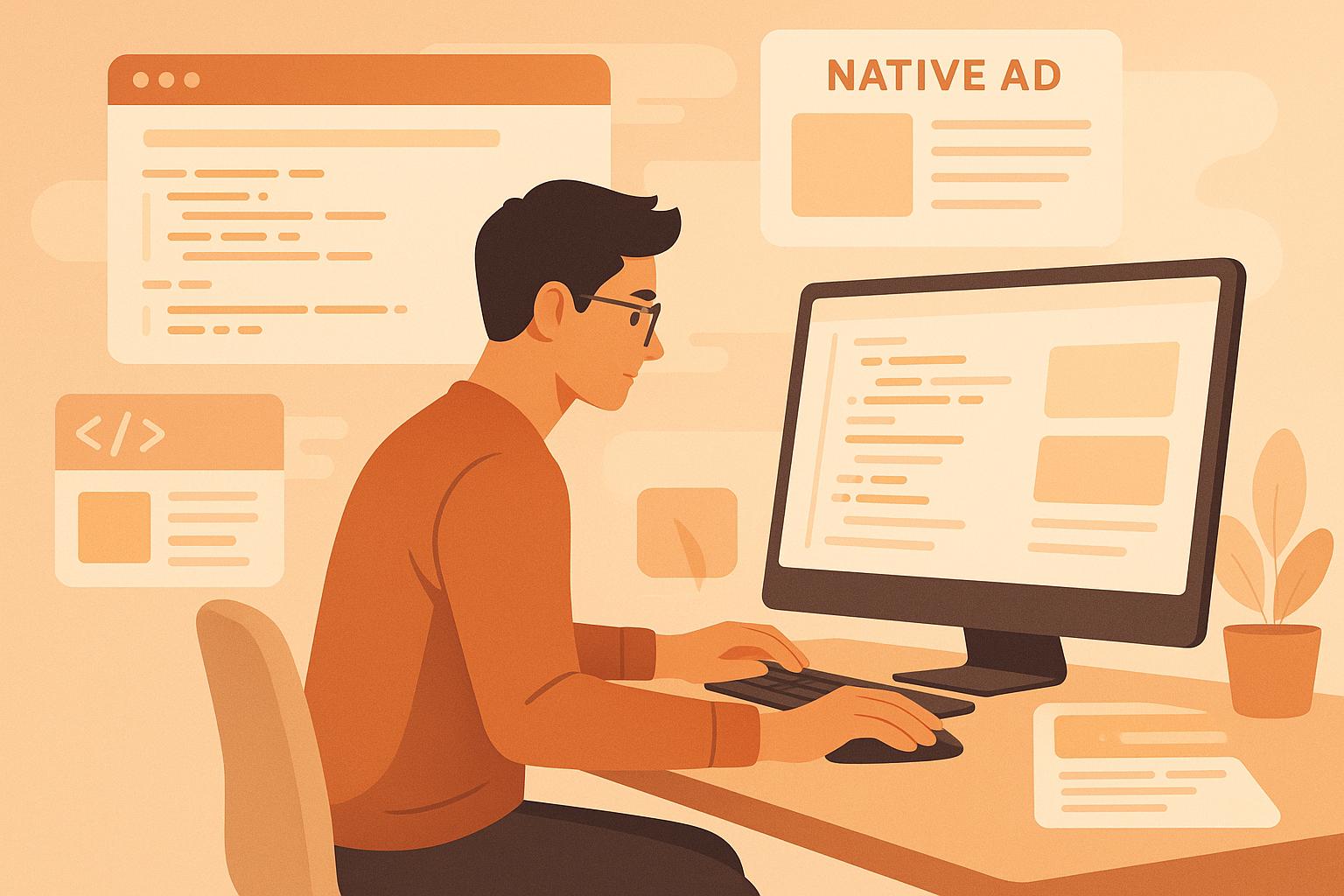


Effective developer marketing resembles onboarding, focusing on education and trust rather than traditional advertising tactics.
Developers don’t like being sold to - they value tools that solve problems, clear documentation, and hands-on access. Marketing to developers works best when it feels like onboarding rather than traditional advertising. Why? Because onboarding focuses on education, trust, and offering immediate value, while ads often interrupt and fail to connect.
Key takeaways:
- Developers avoid ads: They skip flashy promotions and go straight to documentation or GitHub.
- Onboarding builds trust: Hands-on trials, tutorials, and clear communication resonate more than sales pitches.
- Real results: Companies with strong onboarding see up to 82% higher retention and 70% productivity boosts.
Why developers hate your marketing
Key Elements of Onboarding-Style Developer Marketing
Onboarding-style marketing for developers thrives on three essential principles that mirror effective developer onboarding practices. These principles focus on building trust, offering real value, and aligning with how developers prefer to learn and evaluate tools.
Education and Hands-On Learning
Developers learn best by doing. Effective marketing for developers prioritizes interactive, hands-on experiences over traditional sales pitches. Instead of trying to sell, the focus should be on teaching.
Consider this: companies with structured onboarding frameworks see up to 50% more productive employees. The same logic applies to marketing - educating developers through hands-on experiences lays the groundwork for lasting engagement rather than short-term gains.
To achieve this, combine clear, detailed documentation (covering APIs, libraries, and SDKs) with practical learning opportunities. Tutorials, real-world examples, and case studies that address common developer challenges can make a huge impact. For example, companies like GitLab and Dropbox have shown how practical, application-based learning helps developers understand tools more effectively than theoretical explanations.
This hands-on approach naturally paves the way for the next critical piece: transparent communication.
Clear Communication and Developer Independence
Developers value honesty and autonomy. They want to know exactly what a product can and cannot do, without the fluff. Transparency builds credibility, while allowing developers to explore solutions at their own pace fosters trust.
Being upfront about your product’s capabilities, limitations, and integration requirements is key. As Łukasz Sowa, Founder @ Iterators, explains:
"Developer onboarding isn't just about introducing tools; it's about creating a structured pathway that aligns technical skill-building with company culture."
- Łukasz Sowa
Clear communication means providing developers with the resources they need when they need them. This includes detailed knowledge bases, quick-start guides, and comprehensive technical documentation. Strong onboarding processes can cut the time it takes for developers to become fully functional by up to 50%. By respecting their expertise and delivering the right information at the right moment, you empower developers to make informed decisions.
Step-by-Step Help Instead of Sales Pitches
Building on clear communication, step-by-step guidance is another way to empower developers. Instead of overwhelming them with sales pitches, focus on solving real problems and integrating solutions seamlessly into their workflows.
Take inspiration from companies like Netflix and Stack Overflow. Their onboarding processes build confidence by providing gradual, actionable guidance that delivers value from the very beginning. While these examples come from employee onboarding, the same principle applies to developer marketing - step-by-step assistance encourages deeper engagement with your product.
When creating content, aim to break down complex tasks into manageable steps. Whether it’s integrating an API, improving performance, or tackling common technical issues, actionable guidance makes a big difference. For instance, Palantir uses a tiered review system where new engineers initially have their code reviewed by senior architects. Once they’ve demonstrated proficiency, they move on to standard peer reviews. This kind of structured, incremental approach can be mirrored in your marketing to help developers gain confidence and mastery over time.
How to Build Onboarding-Style Marketing Campaigns
Craft campaigns that guide developers through discovery and learning rather than simply presenting features. The goal is to educate, demonstrate value, and respect developers' time and expertise.
The foundation of this approach lies in understanding that 67% of B2B buyers now rely more on content to research and make purchasing decisions than they did a year ago. Developers, in particular, seek hands-on experiences to truly evaluate tools.
Interactive Demos and Step-by-Step Tutorials
Interactive, step-by-step content is an excellent way to implement this onboarding-focused strategy. Interactive demos transform passive viewers into active participants. When developers can try a product firsthand, they’re more likely to grasp its value and remember the experience. In fact, interactive learning can increase engagement and retention by up to 75–80%, making it one of the most effective ways to connect with this audience.
For interactive demos to succeed, focus on showcasing your product's most compelling features while keeping the experience streamlined and actionable. Developers don’t want to be sold to - they want to see how a solution works and how it solves their challenges.
When creating tutorials, organize the content in a logical or chronological order to help developers understand how different functionalities fit together. Use visual aids like infographics to clarify complex concepts, and include interactive elements such as quizzes or exercises. Visuals are especially powerful - they can improve retention rates by 65%.
Break down complex processes into simple steps with clear calls-to-action that guide developers through their journey. Tailor your demos to specific challenges. For instance, a React-focused frontend developer will have different needs from a DevOps engineer managing cloud infrastructure. Always ask for feedback after each session to improve future presentations.
Native Ad Formats That Fit Developer Workflows
Native advertising works well because it blends seamlessly into developers' existing workflows. Native ads have a click-through rate 40 times higher than traditional display ads, largely because they feel like a natural extension of the content developers are already engaging with.
Platforms like daily.dev Ads excel by offering native ad placements that align with developer content. For example, in-feed ads appear alongside curated articles, while post-page ads provide additional context after developers finish reading relevant material. These formats respect developers’ preferences by maintaining visual consistency and adding value without disrupting their experience.
The most effective native ads are easy to discover, actionable, and non-intrusive. They should match the fonts, colors, and styles of the surrounding content while clearly indicating they’re sponsored. Transparency is crucial - developers value honesty and straightforward communication.
When designing native ads, consider the complete user journey. What are developers doing before, during, and after they see your ad? Are they researching a problem or exploring tool options? Understanding this context helps you create ads that feel helpful rather than intrusive.
Continuously test different ad designs and placements. About 25% of visitors leave a page if it takes longer than four seconds to load, so ensure your ads load quickly and don’t include frustrating elements like pop-ups or overlapping text. Developers appreciate efficiency and clarity.
Targeted Messaging Based on Developer Needs
While seamless native ads integrate into workflows, precise messaging ensures your content addresses developers’ specific challenges. Combine interactive demos and native ads with messaging that speaks directly to the unique needs of your audience, creating a cohesive onboarding journey.
Precision targeting transforms generic messages into tailored, contextual communications. Platforms like daily.dev Ads enable targeting based on seniority, programming languages, tools, and interests. This allows you to craft messages that align with developers’ current goals and challenges.
Go beyond basic demographics and consider behavioral patterns and technical preferences. A senior Python developer working on machine learning projects will need different messaging than a junior JavaScript developer focused on web applications. Addressing these distinctions ensures your campaigns feel relevant rather than generic.
Segment your audience by behavior, needs, and roles within development teams. For example, a DevOps engineer focused on deployment automation will respond differently to messaging about monitoring tools than a backend developer concerned with API performance. Understanding these nuances helps you create campaigns that resonate on a personal level.
Be clear and concise in your messaging. Developers are busy and want to understand the benefits immediately. Instead of lengthy explanations, focus on specific outcomes and measurable results. Use concrete examples and data-driven claims - developers value facts over flashy marketing.
Tailor your content to different experience levels. Junior developers may need more educational materials and step-by-step instructions, while senior developers often prefer technical depth and integration details. Your targeting strategy should reflect these preferences, delivering the right content to each audience segment.
Keep in mind that 80% of customers believe a company’s brand experience is as important as its products. Your messaging should consistently reflect your commitment to helping developers succeed, whether you're addressing frontend specialists or full-stack developers.
sbb-itb-e54ba74
Matching Marketing to Developer Work Patterns
To effectively market to developers, you need to understand how they work, think, and make decisions. Developers focus on functionality and utility, often placing less importance on aesthetics or flashy promotions. This means your campaigns should feel like a natural part of their workflow rather than an interruption. By aligning with how developers operate, you can create marketing strategies that resonate.
"Marketing to developers requires a different approach than marketing to consumers. Developers are highly analytical, technically savvy, and prioritize functionality and utility over aesthetics and hype." – Amit Ashwini
The goal is to craft campaigns that fit seamlessly into developers' routines. When marketers respect their processes and offer authentic, useful resources, developers are more likely to engage and adopt the product. This understanding is essential for mapping out their journey.
Understanding the Developer Journey
The developer journey spans every stage, from discovering your product to scaling its use. Unlike a typical linear customer journey, developers may interact with your tool in various ways. They might find it on GitHub, test it in a sandbox, discuss it with their team, and return to it later when solving a specific problem. By identifying these touchpoints, you can design strategies that meet developers wherever they are in their process.
Take HashiCorp as an example. They built a strong reputation by offering free tools and fostering open-source contributions. Their Terraform product gained traction because developers could experiment in low-risk environments, share their experiences, and even contribute to its development. Similarly, companies like Stripe and Twilio focus on developer-first documentation, ensuring their APIs are easy to understand and implement.
Other companies have also succeeded by reducing friction for developers. Postman and MongoDB, for instance, provide instant sandbox accounts, interactive documentation, and automated provisioning, making it easy for developers to start experimenting. DigitalOcean and Vercel have taken a community-driven approach by engaging directly with developers on platforms like GitHub, hosting live coding sessions, and organizing hackathons. These examples highlight how seamless integration into developers' workflows can drive adoption and loyalty.
Using Local Formats and Standards
In a global landscape, developers appreciate when content aligns with their local standards. For an American audience, this means using USD ($), imperial measurements where applicable, and the US date format (MM/DD/YYYY). These small details enhance credibility and make your materials feel more relevant.
Avoid marketing buzzwords and focus on providing practical resources. Developers value straightforward communication backed by actionable tools. Examples include:
- Code samples to automate repetitive tasks
- Screencasts demonstrating API integrations with GitHub projects
- Command-line interface (CLI) tools for direct API calls
- Interactive documentation that allows users to test requests by adjusting parameters and reviewing responses
Platforms like daily.dev Ads excel at targeting specific developer segments using criteria such as programming languages, tools, and technical interests. This precision ensures your messaging reaches the right audience.
Getting Feedback and Making Improvements
Tailored messaging and localized content are just the start - feedback is essential for long-term success. Developers, with their technical expertise, can provide detailed insights into what works and what needs improvement. Actively engaging with this feedback can help refine both your product and your marketing efforts.
Supabase is a prime example of this approach. By embracing open-source principles and fostering active community engagement, they’ve grown rapidly. Their responsiveness to user feedback and commitment to iterative improvements have been key to their success.
To gather feedback, establish channels that naturally align with developers' workflows, such as GitHub issues, Discord servers, and community forums. Be present in these spaces, respond to suggestions, and show that you’re listening. This kind of engagement turns users into advocates.
Finally, analyze both quantitative data (like how developers interact with your demos and documentation) and qualitative feedback. Look for patterns that reveal opportunities for improvement. By treating marketing as a two-way conversation, you can build trust, foster collaboration, and create lasting relationships with your audience.
Onboarding vs. Traditional Advertising: A Side-by-Side Comparison
When you compare onboarding-style marketing to traditional advertising, the differences in how each engages developers are striking. Traditional advertising often interrupts with broad, generic messages, while onboarding-style marketing seamlessly fits into developer workflows, offering something valuable in return.
Traditional advertising casts a wide net, relying on general messaging. Onboarding marketing, on the other hand, zeroes in on specific developer groups, using interactive and hands-on methods to connect.
Another key difference lies in how success is measured and feedback is handled. Traditional advertising struggles with limited tracking capabilities and requires significant time to implement changes. In contrast, onboarding-style marketing thrives on real-time analytics, allowing for quick adjustments based on performance and feedback.
To make the distinctions even clearer, here’s a breakdown of the two approaches:
Comparison Table: Onboarding vs. Advertising Methods
| Aspect | Traditional Advertising | Onboarding-Style Marketing |
|---|---|---|
| Audience Focus | Broad, mass market reach | Targeted developer segments |
| Communication Style | One-way, interruptive messaging | Interactive, two-way engagement |
| Content Format | Static ads, promotional materials | Interactive demos, tutorials, code samples |
| Success Metrics | Brand awareness, reach, impressions | Engagement rates, retention, adoption |
| Tracking Capabilities | Limited ROI measurement | Real-time analytics, detailed data |
| Flexibility | Slow to adapt, longer lead times | Quick adjustments based on performance |
| Developer Experience | Disrupts workflow | Seamlessly integrates into workflow |
| Trust Building | Relies on brand reputation | Builds trust through value delivery |
| Retention Impact | Minimal long-term engagement | 50% higher retention rates |
The benefits of onboarding marketing go beyond just engagement - it significantly improves developer retention. Strong onboarding processes lead to 50% higher retention rates after the first month, and 77% of users value a well-designed onboarding experience as essential for continued usage. Traditional advertising simply falls short when it comes to fostering this kind of long-term connection.
"Onboarding is one of the first experiences developers have with your product... You want to impress your users straight away and prevent churn, so it's crucial you onboard them right." – Teresa Garanhel, Content Lead and Strategist, Product Marketing Alliance
Platforms like daily.dev Ads support this approach by offering native placements that blend into developers’ daily workflows. These placements act as helpful resources, enriching their learning and problem-solving routines.
At its core, the difference between these two approaches lies in their intent and execution. Traditional advertising aims to grab attention quickly, often prioritizing short-term conversions through promotional messages. Onboarding marketing, however, focuses on education, guidance, and building long-term trust. Developers need time to explore, experiment, and feel confident in a product before fully committing. By prioritizing hands-on learning and offering meaningful value, onboarding marketing fosters relationships that traditional advertising simply cannot achieve.
Conclusion: Building Trust Through Onboarding-Style Marketing
Transitioning to an onboarding-style approach isn't just a tweak to your strategy - it's a major shift in how businesses connect with developers. Instead of relying on traditional advertising, this method prioritizes educational, transparent, and relevant content. The result? Stronger, more meaningful relationships that lead to measurable outcomes.
The numbers back this up. Studies show that product-led onboarding can boost activation rates by 30%, while poor onboarding practices can cause up to 75% of new users to drop off within the first week. These stats highlight a crucial point: developers don’t want to be sold to - they want tools and knowledge that help them do their jobs better.
Take Slack, for example. By using guided workflows and interactive simulations, they saw a 30% increase in team activation rates. Canva achieved even more striking results: 85% of users created their first design within just 10 minutes, thanks to their focus on step-by-step guidance instead of promotional content. These examples show how blending marketing with user experience can deliver incredible results.
This approach isn't just about short-term gains. Research shows that strong onboarding processes can lead to retention rates 70% higher after three years. By offering interactive demos, thorough documentation, and hands-on tutorials, you create trust - and that trust fuels long-term growth.
"Developer onboarding isn't just about introducing tools; it's about creating a structured pathway that aligns technical skill-building with company culture." - Łukasz Sowa, Founder @ Iterators
Platforms like daily.dev Ads are designed to support this philosophy. They integrate seamlessly into developers' workflows, offering native placements and precise targeting to deliver content tailored to specific needs, programming languages, and experience levels.
Ultimately, onboarding-style marketing is about more than just engagement - it's about creating lasting value. When your marketing feels like onboarding, you're not just gaining users; you're building a community of loyal advocates who trust your brand and help drive its long-term success.
FAQs
What makes onboarding-style marketing more effective than traditional advertising for engaging developers?
Onboarding-style marketing takes a different approach by offering practical, hands-on experiences that deliver immediate value to developers. Instead of sticking to broad or generic messages, it focuses on providing tools like detailed documentation, interactive tutorials, and open APIs. These resources make it easier for developers to dive in and start using the tools without unnecessary hurdles.
This method creates trust while minimizing friction, matching the way developers naturally prefer to learn and solve problems. In contrast, traditional advertising often uses push-based messaging, which can come across as impersonal and out of touch with developers' real needs. By focusing on education and empowering users, onboarding-style marketing encourages stronger engagement and builds lasting loyalty.
How can I create interactive demos that truly engage developers?
When designing interactive demos for developers, aim to keep them concise, purpose-driven, and user-friendly. Incorporate straightforward visuals, use relatable data, and guide users through intuitive steps to create a smooth experience. To make the demos more engaging, consider adding quizzes or challenges that encourage active participation. Also, ensure your demos work well on mobile devices and across different browsers, so they’re accessible to everyone.
Why is clear communication and transparency essential in developer marketing, and how can brands achieve it effectively?
Clear communication and transparency are essential in developer marketing because they establish trust, demonstrate respect for developers' time, and ensure expectations are realistic. Developers appreciate honesty and directness, so being clear about what your product can and cannot do helps build credibility.
Here’s how you can put this into practice:
- Provide accurate and detailed information about your product or service.
- Focus on solving real challenges developers face, offering solutions that integrate seamlessly into their workflows.
- Keep developers informed by openly sharing updates and processes, making them feel included and valued.
This approach doesn’t just resonate with developers - it strengthens long-term loyalty by aligning with their goals and priorities.






